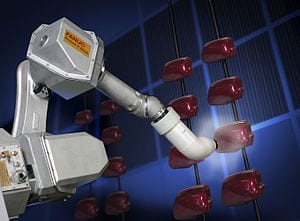A significant bet that robots in the future will work directly with humans in the workplace
If you grab the hand of a two-armed robot named Baxter, it will turn its head and a pair of cartoon eyes — displayed on a tablet-size computer-screen “face” — will peer at you with interest.
The sensation that Baxter conveys is not creepy, but benign, perhaps even disarmingly friendly. And that is intentional.
Baxter, the first product of Rethink Robotics, an ambitious start-up company in a revived manufacturing district here, is a significant bet that robots in the future will work directly with humans in the workplace.
That is a marked shift from today’s machines, which are kept safely isolated from humans, either inside glass cages or behind laser-controlled “light curtains,” because they move with Terminator-like speed and accuracy and could flatten any human they encountered.
By contrast, Baxter, which comes encased in plastic and has a nine-foot “wingspan,” is relatively slow and imprecise in the way it moves. And it has an elaborate array of safety mechanisms and sensors to protect the human workers it assists.
Here in a brick factory that was once one of the first electrified manufacturing sites in New England, Rodney A. Brooks, the legendary roboticist who is Rethink’s founder, proves its safety by placing his head in the path of Baxter’s arm while it moves objects on an assembly line.
The arm senses his head and abruptly stops moving with a soft clunk. Dr. Brooks, unfazed, points out that the arm is what roboticists call “compliant”: intended to sense unexpected obstacles and adjust itself accordingly.
The $22,000 robot that Rethink will begin selling in October is the clearest evidence yet that robotics is more than a laboratory curiosity or a tool only for large companies with vast amounts of capital. The company is betting it can broaden the market for robots by selling an inexpensive machine that can collaborate with human workers, the way the computer industry took off in the 1980s when the prices of PCs fell sharply and people without programming experience could start using them right out of the box.
“It feels like a true Macintosh moment for the robot world,” said Tony Fadell, the former Apple executive who oversaw the development of the iPod and the iPhone.
Baxter will come equipped with a library of simple tasks, or behaviors — for example, a “common sense” capability to recognize it must have an object in its hand before it can move and release it.
Although it will be possible to program Baxter, the Rethink designers avoid the term. Instead they talk about “training by demonstration.” For example, to pick up an object and move it, a human will instruct the robot by physically moving its arm and making it grab the object.
The robot’s redundant layers of safety mechanisms include a crown of sonar sensors ringing its head that automatically slows its movements whenever a human approaches. Its computer-screen face turns red to let workers know that it is aware of their presence.
via The New York Times
The Latest Streaming News: Robots working with humans updated minute-by-minute
Bookmark this page and come back often
Latest NEWS
Latest VIDEO









